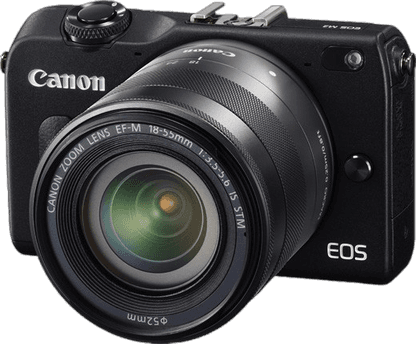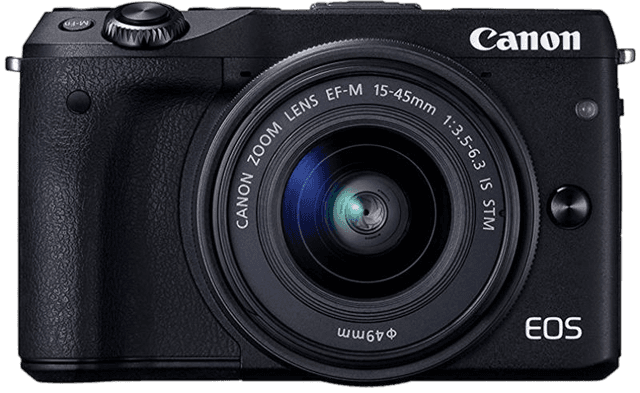Canon EOS M2 vs EOS M3 Comparison
Canon EOS M2

Canon EOS M3

The Canon EOS M3 comes out on top with a score of 56/100, while the Canon EOS M2 trails behind with a score of 46/100. Both cameras are mirrorless and share similarities in their launch prices, with the M2 at $650 and the M3 at $870. The EOS M3 surpasses the M2 in design, boasting a smaller and lighter body at 111 x 68 x 44mm and weighing 366g. The M2, on the other hand, measures 116 x 88 x 59mm and weighs 387g.
While the EOS M2 has its merits, the EOS M3’s superior design and higher overall score make it the clear winner in this comparison.
Canon EOS M2 vs EOS M3 Overview and Optics
The Canon EOS M3 outperforms the Canon EOS M2 in optics, scoring 60/100 compared to the M2’s 44/100. Both cameras share some common specifications, such as the CMOS sensor type, APS-C sensor size, Canon EF-M lens mount, and the absence of image stabilization.
The M3’s superior optics are primarily due to its higher megapixel count and improved DXOMARK sensor score. With 24.2 megapixels, the M3 captures more detail in images than the M2, which has 18 megapixels. Additionally, the M3’s sensor has a DXOMARK score of 72, compared to the M2’s score of 65, indicating better overall image quality.
In terms of shooting speed, the M2 has the advantage with 10 frames per second (fps), while the M3 is limited to 4.2 fps. This makes the M2 more suitable for capturing fast-moving subjects or action photography.
The M3 is equipped with a more advanced processor, the Digic 6, while the M2 uses the Digic 8. Despite the M2 having a newer processor, the M3’s improved optics and image quality outweigh the processing advantage of the M2.
Taking into account the differences in optics, the Canon EOS M3 is the better choice for photographers who prioritize image quality and detail. The higher megapixel count and better sensor performance contribute to its higher score in optics. However, the Canon EOS M2 may be more suitable for those who require faster shooting speeds for action photography.
Canon EOS M2 vs EOS M3 Video Performance
The Canon EOS M2 emerges as the winner in video capabilities, scoring 57/100, while the Canon EOS M3 scores 43/100. Both cameras share some common video specifications, including Full HD video resolution, max video dimensions of 1920 x 1080, and a max video frame rate of 30fps.
The EOS M2 gains the upper hand with its built-in time-lapse functionality, which the EOS M3 lacks. This feature allows photographers to capture stunning time-lapse videos without the need for additional equipment or software. The higher score of the EOS M2 reflects its superior video capabilities, making it a better choice for those who prioritize video performance.
On the other hand, the EOS M3 offers the same core video specifications as the EOS M2, such as Full HD resolution and 30fps frame rate. However, it does not excel beyond these shared features, resulting in a lower score. While the EOS M3 might not be the top choice for videographers, it still provides decent video capabilities for casual users or those who do not require time-lapse functionality.
Both the Canon EOS M2 and the Canon EOS M3 offer commendable video capabilities, with the EOS M2 standing out due to its built-in time-lapse feature. For those seeking more advanced video features, the EOS M2 is the better choice, while the EOS M3 remains a suitable option for those who do not require time-lapse functionality. Ultimately, the choice between these cameras will depend on the user’s specific video needs and preferences.
Canon EOS M2 vs EOS M3 Features and Benefits
The Canon EOS M2 and Canon EOS M3 both have a feature score of 57 out of 100. Despite having the same score, there are differences in their features that make one camera more advantageous than the other in certain aspects.
Both cameras have a 3-inch screen size and a screen resolution of 1,040,000 dots. They also both have touchscreen capabilities, GPS, WIFI, and lack Bluetooth connectivity. These similarities allow users to enjoy the same level of convenience and connectivity with either camera.
The Canon EOS M3 stands out due to its flip screen feature, which the Canon EOS M2 does not have. This feature is beneficial for users who take selfies or record videos, as it allows them to easily view the screen while capturing images. The flip screen also provides the flexibility to shoot from various angles, making it easier to capture creative shots.
On the other hand, the Canon EOS M2 offers no distinct advantages over the Canon EOS M3 in terms of features. Both cameras share the same feature score and a majority of their specifications.
In terms of features, the Canon EOS M3 is a better option for users who value the convenience of a flip screen. The Canon EOS M2, while not having any specific advantages, is still a viable option for those who do not require a flip screen and prefer a camera with similar specifications and features. Ultimately, the choice between these two cameras will depend on the user’s specific needs and preferences.
Canon EOS M2 vs EOS M3 Storage and Battery
The Canon EOS M2 wins the storage and battery comparison with a score of 21/100, while the Canon EOS M3 scores 16/100. Both cameras share similarities, such as having one memory card slot and accepting SD, SDHC, and SDXC memory cards. Neither camera offers USB charging.
The EOS M2 outperforms the EOS M3 in battery life, providing 305 shots per charge compared to the M3’s 250 shots. This longer battery life is due to the M2 using the LP-E12 battery type. On the other hand, the EOS M3 utilizes the LP-E17 battery type, which results in a shorter battery life.
While the EOS M2 has the advantage of longer battery life, the EOS M3 does not offer any significant benefits in terms of storage and battery. Therefore, the Canon EOS M2 is the better choice for those prioritizing storage and battery capabilities.
Canon EOS M2 vs EOS M3 – Our Verdict
Are you still undecided about which camera is right for you? Have a look at these popular comparisons that feature the Canon EOS M2 or the Canon EOS M3:

